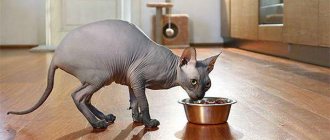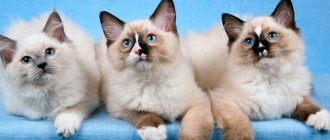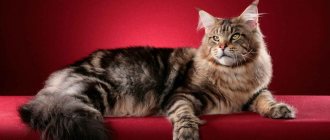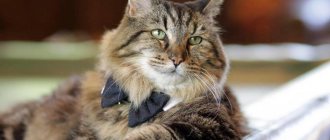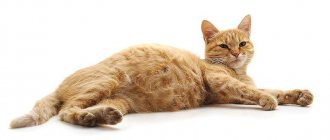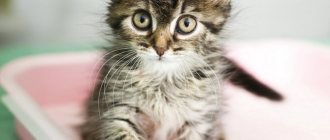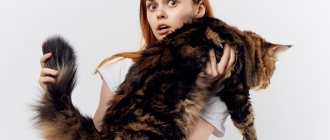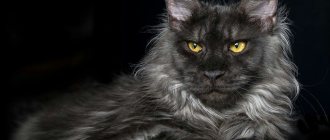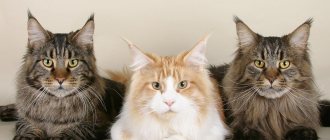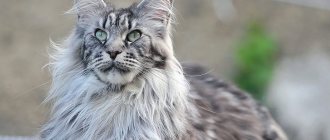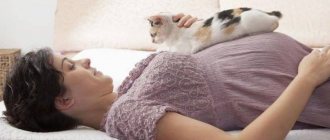Pregnancy in Maine Coons is longer than in other cat breeds. Therefore, kittens appear on average 7 - 10 days later than usual. How do the first signs of pregnancy appear and when should you expect babies? How to help the expectant mother and what complications may there be? What should a first aid kit consist of and what should be the place for childbirth? As well as advice on caring for a woman in labor.
First signs
The first signs of pregnancy appear approximately 3 weeks after the start of the last estrus. These include:
- Swelling of the cat's nipples (they become bright pink).
- Slight weight gain.
- No heat. The cat calms down and no longer asks for the cat.
- Changes in taste preferences (for example, the expectant mother begins to show interest in food to which she was previously indifferent, and vice versa).
There are no tests for feline pregnancy, but an interesting situation can be detected through ultrasound.
Progression by week
Veterinarians distinguish the following stages of pregnancy by week:
- 3 weeks after mating, the first signs appear.
- At 3–4 weeks, the cat develops toxicosis (due to hormonal changes). In this case, drowsiness occurs and appetite worsens.
- In the fifth week, the expectant mother noticeably gains weight. The cat's appetite improves and its belly becomes rounder. The pet becomes calmer and more affectionate.
- At 6 - 8 weeks, kittens begin to move (this can be noticed when observing the pet). Maine-kunsha becomes anxious and tries to find a secluded place to give birth.
- The ninth and part of the tenth week is the last period of gestation. The pet loses its appetite and begins to actively lick its belly and vulva.
During the period of contractions, the cat rushes about in search of a suitable place and meows loudly, attracting the owner’s attention and demanding help and care from him. This period lasts about a day, after which labor begins.
When are we expecting babies and how many will there be?
A pregnant cat lasts an average of 9 - 10 weeks (or 70 - 72 days).
Moreover, the duration of gestation greatly depends on the number of kittens in the litter.
The more there are, the sooner they will be born (in order to reduce the load on the body, the cat gives birth faster).
Babies born before the 62nd day have poor health and therefore require special care (otherwise they risk not surviving). In Maine Coons, the number of kittens in a litter is approximately 4 - 6, but there are cases where cats of this breed carried 10 kittens.
It is not recommended to feel the belly of a expectant mother in order to determine the number of fetuses in the womb, since it is possible to damage the vital organs of the cat - the mother or the offspring she is carrying.
When you need veterinary help
Typically, difficulties arise when a Maine Coon cat gives birth for the first time, and newborns are born with difficulty. You need to call a veterinarian for help if:
- The contractions lasted more than 2 hours, but not a single baby appeared.
- Heavy bleeding began immediately or after childbirth.
- Mom’s temperature dropped below 37 degrees or rose above 40.
- The fetus remains in the birth canal without movement for more than 10 minutes.
The first birth of a Maine Coon is an exciting event, but you should not worry more than necessary. On the contrary, you should study all the necessary information and be ready to provide qualified assistance to your cat. This will allow the owner to react correctly if something goes wrong.
Help for the expectant mother
The appropriate age for the first pregnancy is 8 - 10 months.
It is during this period (not earlier) that the pet is physically and hormonally ready to become a mother.
The correct course of pregnancy and appropriate care will help not only to avoid complications in the process of bearing kittens and subsequent births, but also to maintain the health of the cat.
It is advisable to start taking care of the animal even before mating with a cat. Therefore, it is important for the owner to know the basics of proper pet care (food, rest, help during toxicosis).
Adviсe
During Maine Coon pregnancy, it is better to provide the cat with a calm, cozy place. Avoid stressing your pet, including delaying vaccinations if possible.
The Maine Coon is a breed that is distinguished by its demands for attention from members of the household. During pregnancy, it is important to focus on the animal’s nutrition and provide it with a balanced diet.
Otherwise, your pet may experience complications. For the formation and development of healthy kittens, you can give the mother in labor vitamins.
It is better to discuss this issue with a specialist and select dietary supplements according to his recommendations, so as not to encounter side effects.
During pregnancy, it is best to leave a Maine Coon alone/Yandex Collections
To maintain the health of the expectant mother, it is better to start preparing for pregnancy in advance. The optimal age for the first mating is no earlier than eight months, after the third heat.
Before pregnancy, it is also important to monitor the stability of your pet’s hormonal levels.
Toxicosis
The cause of toxicosis in cats is hormonal changes in the body, and in some cases, poor diet. Characteristic symptoms:
- Vomiting in the morning (has a light color and does not contain traces of blood or bile).
- Drowsiness and weakness.
- Increased nervousness.
- Decreased appetite.
- Unhealthy coat.
If you notice signs of toxicosis in a cat, you should not panic, because this is a normal physiological reaction to changes in hormonal levels. Toxicosis, as a rule, can be observed at 2 - 4 weeks of pregnancy, and it lasts on average about 10 days. Usually this condition does not require treatment and goes away on its own. But in case of prolonged toxicosis or significant deterioration of the condition, it is recommended to show the animal to a veterinarian.
How long does pregnancy last in Maine Coon cats?
The Maine Coon is an American cat breed that appeared about 250 years ago. They are considered one of the largest cat breeds in the world. Maine Coons grow up to five years old and can reach a weight of 16 kg. They have the most incredible colors.
They can be described as an animal with high intelligence, a friendly character and the ability to train. They differ not only in their peculiar behavior and physiology, but also in their gestational age.
So how long does pregnancy last for Maine Coons?
Maine Coon cats have a longer gestation period than others / Yandex Collections
Nutrition and vitamins
Proper nutrition during pregnancy plays an important role in the formation of future babies. Therefore, veterinarians advise feeding your cat a balanced diet (there are special product lines designed for pregnant women). In addition to the daily diet, you can give your furry pet vitamins (Doctor Zoo, Seva, Canina, etc.).
You should not combine fortified feed and vitamins, as this can lead to the development of vitamin deficiency.
Mixed feeding
Mixed nutrition includes primarily dry industrial food; natural products in this case serve as additional food. When feeding a Maine Coon in a balanced diet, meat products should not exceed 20%, otherwise the pet may get carried away. In this case, you will have to completely switch to natural food and independently calculate all the nutrients in the bowl, or the cat should eat only industrial food that does not require additional additives.
Selecting a location
The place for cat birth must be prepared in advance.
A large cardboard box is perfect for this purpose (approximate parameters: length and width at least 90 cm, height - 50 cm).
At the same time, one wall of the box needs to be trimmed a little so that it is convenient for the nursing mother to jump into the house (including so that she does not crush the kittens).
It is recommended to place soft bedding at the bottom of the box. During pregnancy, the cat needs to be introduced to the place for future birth. It is advisable to place the box in a quiet place where no one will disturb the mother and kittens.
Necessary preparation
After successful conception, the formation of future kittens begins, which takes 60-65 days. During this time, it is recommended to find a veterinarian who is ready to provide emergency medical care at home in case of complications.
Arrangement of the place
During and after birth, the cat will need a secluded corner. It is better to prepare it in advance. Otherwise, the pet will hide under the sofa, which will prevent free access to her and the kittens. To build and equip a “maternity hospital” you will need:
- Big box. Make sure that it will accommodate not only the new mother, but also her offspring.
- Soft bedding or blanket. Place a disposable baby diaper under them to prevent the cardboard from getting wet.
- Bowls for water and food. You also need to add a tray. After giving birth, the cat should rest and not run to the other end of the house to relieve itself.
We invite you to read: Valerian for cats: action, reaction, harm and benefit, where does such love come from?
The constructed space must be accessible and spacious. Isolate it from possible threats (children, other pets, drafts) by choosing the quietest and most secure room in the house.
A week before the onset of a responsible time, prepare an “alarm suitcase”. He must be kept close until contractions begin. The content should be as follows:
- antiseptics and Oxytocin;
- small syringe;
- cotton pads and gloves;
- water container;
- separate box for newborns;
- clean towels or cotton fabrics;
- sterile threads and napkins;
- warmer;
- pipette and rubber bulb;
- scissors disinfected with alcohol;
- dry milk mixture.
All these things should be stored in one place. The number of tools and materials needed depends on the severity of the lambing.
What not to do
Cats usually give birth when it's late afternoon or even night. During this time, your pet should not be left alone.
Take care of completing all the tasks in advance and give your pregnant pet maximum attention
In case of complications, contact your veterinarian immediately. Trying to fix the problem yourself can kill the animal. Also, avoid using Oxytocin until the last minute. This drug is used to stimulate labor strictly in the presence of certain factors. If the process takes too long, but is not accompanied by complications, be patient. The body will cope with the birth of babies on its own at a pace that is convenient for it.
First aid kit for feline birth
You should stock up on tools for your cat's first aid kit in advance. So, during childbirth you cannot do without the following devices:
- Alcohol for disinfection.
- Scissors.
- Disposable diapers (they can be purchased at a veterinarian's store or pharmacy).
- Soft cloths or napkins (may be needed for rubbing newborn kittens).
If the owner has not previously taken part in a cat’s birth and is afraid, you can call a veterinarian to your home for a fee.
Pedigree feed lines
The rating of special breed feeds includes the following brands:
- Royal Canin Maine Coon;
- Brit Care Tobby I'm a Large Cat;
- Carnilove for Large breed cats (suitable for cats with allergies);
- Flatazor Crocktail Adult Large Breed;
- Leonardo Adult Maxi;
- Nature's Protection Superior Care Large Cat.
The advantages of each brand can be clarified with a veterinarian, Maine Coon breeders, or in video reviews of Royal Canin and Hills food.
Tips for caring for a new mother
The expectant mother requires special attention and special care. During this period, veterinarians recommend adhering to the following rules:
- Trim the hair around the pregnant woman's nipples (with scissors without sharp ends).
- A few weeks before giving birth, protect your pet from sudden movements.
- Spend more time with your cat (especially in the last days before the kittens are born).
- Do not take your pet on long trips.
- Provide your cat with healthy nutrition, peace and comfort.
- Give any medications only after consulting a veterinarian.
- After giving birth, keep the cat's house clean (change the bedding periodically).
- Monitor the color and consistency of your cat’s discharge during the postpartum period. Normally they have a reddish color, but after 4 - 6 days they acquire an increasingly lighter shade. If the cat is very weak, it is necessary to carefully remove discharge from the thighs and vulva using a damp towel.
- Provide the mother in labor with plenty of fluids.
- It is recommended to place bowls with food and water close to the cat's shelter.
- Do not let your pet go for walks during pregnancy and after giving birth (as she can pick up an infection from other cats and cats, and subsequently infect still immature kittens).
If a woman in labor appears weak, refuses to eat, body temperature rises to 38 - 39 degrees, or if the mammary glands become inflamed, consult a veterinarian immediately.
The main pathologies of pregnancy that affect timing
In animals, by nature, everything is built in such a way that basic physiological processes proceed perfectly without human intervention. Domestication has led to the fact that deviations in the bearing and birth of offspring in domestic pets have become increasingly common. This also changes the cat's pregnancy time. What kind of pathologies are these?
Superfetation
This is a fairly rare pathology, characterized by the appearance of estrus (sexual activity) during the current pregnancy. This is a type of hormonal imbalance. If in this state the cat is not protected from the male’s covering, then simultaneously with the main litter, another “batch” of embryos will begin to develop in the womb. It turns out that the fruits from both fertilizations simultaneously develop in the body, but with a difference in development weeks.
The situation usually develops in two ways:
- the first “batch” of kittens is born on time, the second “batch” remains in the womb, and pregnancy continues further along with breastfeeding of newborns. Such cases have only one drawback - there are not enough nipples for everyone after two births, so the owner will have to do the feeding. This is an ideal development of events and it happens very rarely,
- During the birth of the first kittens, miscarriage occurs and the second ones die due to their underdevelopment - this happens in most cases.
False pregnancy (“spoon”)
This pathology is distinguished by the fact that there are no kittens in the womb, but in appearance and behavior it seems that the cat is pregnant: an enlarged abdomen is visible, the mammary glands swell and turn red, and colostrum appears. The catch is that the duration of the “spoon” coincides with the usual time intervals. There is only one difference: the babies do not appear at the set moment. The deviation is hormonal in nature. Most often the condition occurs in Sphynxes and Orientals. It is imperative to contact a veterinarian, because... this pathology leads to inflammatory processes against the background of stagnation of blood in the genitals and severe mastitis.
Owners should pay attention to:
- absence of labor on the due date,
- a little earlier, the absence of fetal movements.
The cat has ascites and looks pregnant
An accurate diagnosis is always made after an ultrasound. Treatment is complex, including normalization of hormonal levels and treatment of concomitant diseases.
Ascites
The exact cause of this pathology against the background of false pregnancy is not known. Experts are more inclined to believe that due to hormonal imbalance, protein metabolism is disrupted and fluid begins to accumulate in the abdominal cavity.
The belly is growing, the owners think that Murka will soon have kittens, but the absence of kicks from the babies in the later stages and behavioral signs in the cat is alarming. Those. There is nothing else except a big belly.
This is already a reason to contact a veterinarian to examine your pet. Ultrasound will be especially informative in this case. The condition, unfortunately, is incurable.
Frozen pregnancy
A serious pathology that occurs against the background of arrested development and death of fetuses in the womb of a cat. There are many reasons for this condition:
- infections,
- hormonal deficiency,
- various inflammations in the abdominal cavity and pelvis,
- injuries
- stress.
Any attentive owner can determine this:
- belly doesn't grow
- there is no movement of the fruits,
- appetite decreases, the cat becomes lethargic, inactive,
- at the beginning of decomposition, signs of general intoxication and self-poisoning appear with fever and vomiting.
Be sure to go to the clinic. An ultrasound is done. If it is confirmed that all the babies are dead, then the cat is aborted in the clinic. If it turns out that there are live fetuses, maintenance therapy is prescribed at the discretion of the veterinarian in order to gain time, allow the living fetuses to develop further, so that Murka gives birth on her own on the set dates. Usually, after such a pathology, it is suggested to carry out sterilization. The risks of relapse are high due to the inability to know exactly why this happened and the lack of ability to prevent a recurrence.
Ectopic pregnancy
A condition in which the egg is implanted in the wrong place and the fetus begins to develop outside the uterus. Outwardly, this state does not manifest itself in anything until a certain time. This often leads to rupture of the main “pregnant” organ, and this, in turn, leads to serious bleeding and intra-abdominal inflammation. The cat requires urgent surgical care. In difficult situations, in order to save Murka from sepsis and necrosis, a caesarean section with sterilization is performed (the animal will not produce any more offspring).
Miscarriage
This is a spontaneous termination of pregnancy in the early stages, when the fetuses are not yet viable and cannot be saved.
There are three types when
- embryos stop developing very, very early and are resorbed.
- kittens die and leave the cat's womb through premature birth.
- the fetuses die, but remain in the womb until the end of the “pregnant” period.
Any of these conditions is pathological and cannot always be predicted. Often this happens suddenly and the owners are late in seeking help. In all cases, the fetuses die, the only difference is at what period of the cat’s pregnancy.
You can suspect a miscarriage based on the following signs:
- foul-smelling discharge appears from the genitals,
- persistent asymmetry of the abdominal walls,
- feverish state, fluctuations in body temperature,
- refusal to eat, vomiting, sudden weight loss,
- inexplicable anxiety.
Possible complications
In the absence of proper nutrition, in case of hypothermia or overheating of the body, if the cat is infected with pathogenic microorganisms, the following complications are possible:
- Miscarriage (usually occurs at 4–5 weeks of pregnancy). In this case, lifeless fetuses may remain in the uterus, which will cause putrefaction and inflammation of the internal genital organs. In this case, you cannot do without the help of a veterinarian.
- Bleeding. It occurs as a result of rupture of the cervix during childbirth: scarlet fluid flows profusely from the vulva, and the cat lies on its side with its tongue hanging out. In the absence of timely treatment, the animal may die.
- Mastitis (inflammation of the mammary glands as a result of excess milk). In this case, redness and soreness of the nipples are observed, and yellowish breast discharge appears. In this case, the cat is isolated from the kittens and special treatment is carried out.
- Metritis (inflammation of the uterus due to infection). In this case, the animal becomes apathetic, the body temperature rises, and there is abundant discharge from the vulva with an unpleasant odor.
- Insufficient amount of milk (occurs, for example, with a large number of kittens, with a lack of adequate nutrition or fluid).
Dry and wet food
Dry and wet cat food is divided into several classes:
- economy (up to 4% meat, flavoring additives, grain fillers and meat production waste);
- premium (up to 10% animal protein, soy and grains may be present);
- super-premium (up to 20% protein from meat, grains present);
- holistic (more than 20% meat protein, grain-free sources of fiber);
Maine Coons should be fed super premium food. Veterinarians recommend choosing the following brands:
- Eukanuba;
- Royal Canin;
- Hill's;
- Nature Holistic;
- Nutro Choice;
- Nature's Protection;
- Go Natural;
- Brit Care;
- Carnilove;
- Farmina N{amp}amp;D;
- Leonardo;
- Summit;
- Bosch;
- Grandorf;
- Acana.
You need to add as much wet food as the cat will eat at one time.
Acana cat food. Bosch cat food. Brit Care cat food. Carnilove cat food. Eukanuba cat food. Cat food Farmina N{amp}amp;D. Go Natural cat food. Grandorf cat food. Leonardo cat food. Nutro Choice cat food. Pronature Holistic cat food. Royal Canin cat food.
